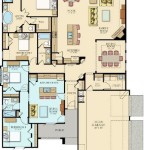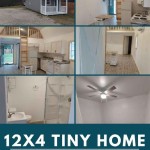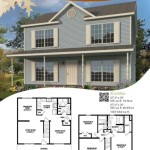Farmhouse Plans With Basement: Creating Your Dream Home
Farmhouse plans with basements offer a compelling blend of traditional charm and modern functionality. The farmhouse aesthetic, characterized by its simplicity, connection to the land, and emphasis on family living, combined with the added space and versatility of a basement, provides an opportunity to create a truly customized and comfortable living environment. This article explores the various aspects of farmhouse plans with basements, guiding individuals through the considerations and options available when designing and building their dream home.
Choosing the right floor plan for a farmhouse with a basement is crucial. The architecture should reflect the classic farmhouse style, incorporating elements like gabled roofs, large porches, and board-and-batten siding. The basement, while often unseen, is integral to the overall design, offering potential for additional living space, storage, or specialized areas. Careful planning ensures the basement complements the above-ground structure and meets the homeowner's specific needs and preferences.
Key Point 1: Maximizing Space and Functionality with a Basement
The primary benefit of incorporating a basement into a farmhouse plan is the significant expansion of usable space. This additional area can be adapted to serve a multitude of purposes, effectively increasing the home's functionality. The basement can be finished to create extra bedrooms, a recreation room, a home theater, or even a dedicated home office. For families with growing children or those who enjoy entertaining, the extra space can be invaluable.
Beyond living areas, basements can also be used for practical storage solutions. Farmhouses often require ample storage for seasonal items, tools, and supplies. A well-designed basement can provide organized and accessible storage, helping to declutter the main living areas. Depending on the climate and region, the basement can also serve as a storm shelter or a safe room during severe weather events.
Furthermore, basements offer the potential for specialized areas tailored to specific hobbies or interests. A dedicated workshop, a crafting studio, a wine cellar, or even a home gym can be incorporated into the basement design. This allows homeowners to pursue their passions without compromising space in the main living area. The basement provides a flexible and adaptable space that enhances the overall living experience.
When planning the basement layout, it's essential to consider factors such as egress windows, natural light sources, and proper ventilation. Egress windows are required for safety in bedrooms and other living areas, providing a means of escape in case of emergency. Natural light can significantly improve the ambiance of the basement, making it feel less like an underground space. Proper ventilation is crucial for preventing moisture buildup and maintaining a healthy indoor air quality.
Key Point 2: Architectural Considerations for Farmhouse Style and Basement Integration
Maintaining the integrity of the farmhouse aesthetic while incorporating a basement requires careful attention to architectural details. The exterior design should reflect the classic farmhouse style, characterized by its simple lines, gabled roofs, and welcoming porches. The basement, while largely unseen from the outside, should be designed to complement the overall structure and minimize any visual impact.
The foundation design is critical for successful basement integration. A poured concrete foundation is a common and durable choice, providing a solid and waterproof base for the home. Proper insulation of the foundation walls is essential for maintaining a comfortable temperature in the basement and preventing moisture condensation. Drainage systems, such as French drains, can help to divert water away from the foundation and prevent water damage.
The entry point to the basement should be carefully considered to ensure accessibility and convenience. Interior stairs leading down from the main living area are the most common option. However, a walk-out basement, where one side of the basement is exposed to the exterior, offers direct access to the outdoors and can significantly enhance the functionality of the space. A walk-out basement also allows for more natural light and ventilation.
The choice of materials for the exterior and interior of the farmhouse should be consistent with the overall aesthetic. Traditional farmhouse materials, such as wood siding, shingle roofing, and exposed beams, can be incorporated into the design. The interior of the basement can be finished to match the style of the main living area, creating a seamless transition between the two spaces. Careful attention to detail and a consistent design theme will result in a cohesive and harmonious living environment.
Key Point 3: Addressing Potential Challenges and Ensuring Long-Term Durability
Building a farmhouse with a basement can present unique challenges that must be addressed during the planning and construction phases. Soil conditions, water management, and radon mitigation are all important considerations. Addressing these challenges effectively will ensure the long-term durability and livability of the home.
Soil conditions can vary significantly depending on the location. A geotechnical investigation should be conducted to assess the soil's bearing capacity, drainage characteristics, and potential for settlement. This information will inform the foundation design and ensure that the structure is adequately supported. Unstable soil may require additional engineering solutions, such as soil compaction or the installation of pilings.
Water management is crucial for preventing water damage in the basement. Proper grading around the foundation is essential for directing water away from the building. Drainage systems, such as French drains and sump pumps, can help to remove water that accumulates around the foundation. Waterproofing the foundation walls is also critical for preventing water from seeping into the basement. Selecting appropriate landscaping and plant placement can also contribute to effective water management around the foundation.
Radon is a naturally occurring radioactive gas that can seep into homes from the soil. Radon mitigation systems should be installed in areas with high radon levels to protect the occupants from exposure. These systems typically involve sealing cracks and openings in the foundation and installing a ventilation system to remove radon gas from beneath the slab. Radon testing should be conducted regularly to ensure the effectiveness of the mitigation system.
Beyond these specific challenges, it's also important to consider the overall maintenance and upkeep of the farmhouse with a basement. Regular inspections of the foundation, drainage systems, and radon mitigation system are essential for identifying and addressing potential problems early on. Proper ventilation and humidity control in the basement are crucial for preventing mold growth and maintaining a healthy indoor air quality. By addressing these challenges proactively, homeowners can ensure the long-term durability and livability of their farmhouse with a basement.
Choosing the right farmhouse plans with a basement involves careful consideration of space requirements, architectural design, and potential challenges. By maximizing space and functionality, integrating the basement seamlessly into the farmhouse style, and addressing potential issues proactively, individuals can create a dream home that combines the charm of a traditional farmhouse with the modern convenience of a spacious and versatile basement. A well-planned and executed farmhouse with a basement can provide a comfortable, functional, and aesthetically pleasing living environment for years to come.

Walkout Basement House Plans Modern Farmhouse Design

Modern Farmhouse Plans With Basements Houseplans Blog Com

Aspen Hill House Plan Modern Farmhouse Craftsman

Farmhouse Plans Floor House The Designers

Dream House Plans Blueprints Floor With Basement

Farmhouse Style House Plan 4 Beds 3 Baths 2390 Sq Ft 430 215 Dreamhomesource Com

Cranberry Gardens House Plan Archival Designs

Hillside Walkout Modern Farmhouse Basement Design

Modern Farmhouse Home Plans From Design Basics

Farmhouse Style House Plan 4 Beds 2 5 Baths 2686 Sq Ft 430 156 Houseplans Com
Related Posts








